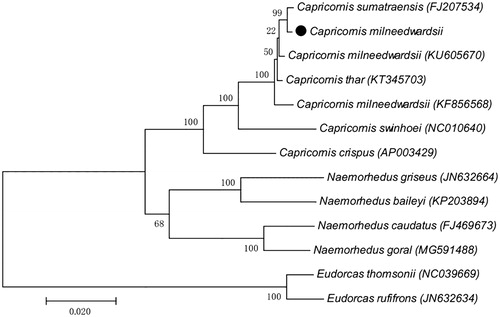Abstract
The complete mitochondrial genome of Chinese serow (Capricornis milneedwardsii) has been described. It is a circular genome of 16,441 bp with a higher A + T content of 60.25%. By reconstructing a Maximum-likelihood (ML) phylogenetic tree, we found that our sample is more closely related to a C. sumatraensis individual from Cambodia (FJ207534) than a Chinese serow individual (KF856568) from closer geographic distance. Therefore, we speculate that our Chinese serow may be a subspecies of C. sumatraensis, and there may be glacial refugia in western Sichuan.
Chinese serow (Capricornis milneedwardsii) is a relatively small ruminant classified in the subfamily Caprinae (Bovidae) (Suwanpugdee et al. Citation2009) and distributed in the mountain area of southern and southeastern Asia (Smith et al. Citation2010). Taxonomy of serow is not completely solved due to the controversies of descriptions, range maps and assessments of conservation status. Based on geographic isolation, Wilson and Reeder (Citation2003) argued that, including Chinese serow, there are six species within the genus Capricornis. However, some scholars depicted that Chinese serow does not reach the level of differentiation of the species (Groves and Grubb Citation1985; Gentry Citation1992).
We collected muscle tissue sample from an illegal poaching Chinese serow individual seized by the Forest Police in Baoxing, Sichuan Province, China (N 45°36′05″, E 128°43′30″). The sample was stored at zoology laboratory, Sichuan Agricultural University (Accession: Sicau –lz –A165). DNA extraction was carried out according to a standard phenol-chloroform’s instructions (Sambrook et al. Citation2001). The complete mitogenome sequence of Capricornis sumatraensis (GeneBank accession number: FJ207534) was downloaded from the National Center for Biotechnology Information (NCBI) and 18 pairs of primers were designed for this study.
The complete mitogenome of Chinese serow is 16,441 bp (GeneBank accession number: MH155202), contains 13 protein-coding genes (PCGs), 2 ribosomal RNA genes (rRNA), 22 transfer RNA genes (tRNA), and 1 control region (CR). The base composition of Chinese serow is A: 33.54%. G: 13.14%, T: 26.70%, and C: 26.61%. AT and GC contents of mitogenome are 60.25% and 39.75%, respectively. 10 PCGs begin with ATG, except for ND2, ND3 initiate with ATA and ND5 start with ATT. For the stop codons, ATP8 gene end with TAG, CYTB gene terminate with AGA, 10 PCGs have stop codon deletion.
To further explore the taxonomic status of Chinese serow and its phylogenetic relationship within the genus Capricornis, we downloaded 12 published complete mitogenome sequences from NCBI, including sequences came from the genus Capricornis and Naemorhedus, the relative of the genus Capricornis. Two species within the genus Eudorcas were served as outgroup, a Maximum-likelihood (ML) phylogenetic tree was reconstructed in MEGA7.0 ().
Figure 1. Maximum-likelihood (ML) phylogenetic tree constructed based on complete mito-genome sequences of Chinese serow and other 10 species within the subfamily Caprinae. E. thomsonii and E. rufifrons were served as outgroup. Number at each node indicates the bootstrap support values. GenBank accession numbers are given in the parentheses. “●” represented the sequence from this study.

In the phylogenetic tree, the genus Capricornis and the genus Naemorhedus clustered into two large branches, respectively. Our sequence clustered with other three species, and showed their close relationship. One of Chinese serow (KF856568) was sampled in Dujiangyan, Sichuan Province (Gong et al. Citation2016), it was only approximately 100km away from our sampling site. However, the closest sequence to ours was the C. sumatraensis (FJ207534) sample from Cambodia (Hassanin et al. Citation2009). On account of that Western Sichuan located the transition from the Hengduan Mountains to the Qinghai-Tibet Plateau, where may be glacial refugia of C. sumatraensis and different matrilines mixed (Liu et al. Citation2013; Favre et al. Citation2015), we speculate our Chinese serow sample may be a subspecies of C. sumatraensis.
Disclosure statement
No potential conflict of interest was reported by the authors.
Additional information
Funding
References
- Favre A, PäCkert M, Pauls S, JäHnig SC, Uhl D, Michalak I, Muellner-Riehl AN. 2015. The role of the uplift of the Qinghai-Tibetan Plateau for the evolution of Tibetan biotas. Biol Rev Cambridge Philos Soc. 90:236–253.
- Gentry AW. 1992. The subfamily and tribes of the family Bovidae. Mammal Rec. 22:1–32.
- Gong S, Peng R, Jiang L, Deng S, Zou F. 2016. The complete mitochondrial genome sequence of the Chinese Serow, Capricornis milneedwardsii (Cetartiodactyla: Caprinae). Mitochondrial DNA Part A. 27:54–55.
- Groves CP, Grubb P. 1985. Reclassification of the serow and goral (Nemorhaedus: Bovidae). In: Lovori H, Editor. The biology and management of mountain ungulates. London: Croom Helm; p. 45–50.
- Hassanin A, Ropiquet A, Couloux A, Cruaud C. 2009. Evolution of the mitochondrial genome in mammals living at high altitude: new insights from a study of the tribe Caprini (Bovidae, Antilopinae). J Mol Evol. 68:293–310. English.
- Liu W, Yao YF, Yu Q, Ni QY, Zhang MW, Yang JD, Mai MM, Xu HL. 2013. Genetic variation and phylogenetic relationship between three serow species of the genus Capricornis based on the complete mitochondrial DNA control region sequences. Mol Biol Rep. 40:6793–6802.
- Sambrook J, Russell D, Maccallum P. 2001. Molecular cloning: a laboratory manual. Immunology. 49:895–909.
- Smith AT, Xie Y, Hoffmann RS, Lunde D, Mackinnon J, Wilson DE, Wozencraft WC. 2010. A Guide to the mammals of China. Changsha: Hunan Education Press.
- Suwanpugdee A, Kornkeawrat K, Saikhun K, Siriaroonrat B, Tipkantha W, Doungsa-Ard K, Sa-Ardrit M, Suthunmapinatha P, Pinyopummin A. 2009. Semen characteristics and sperm morphology of serow (Capricornis sumatraensis). Theriogenology. 71:576–585.
- Wilson DE, Reeder DM. 2003. Mammal species of the world. 3rd ed. Baltimore: The Johns Hopkins University Press.
